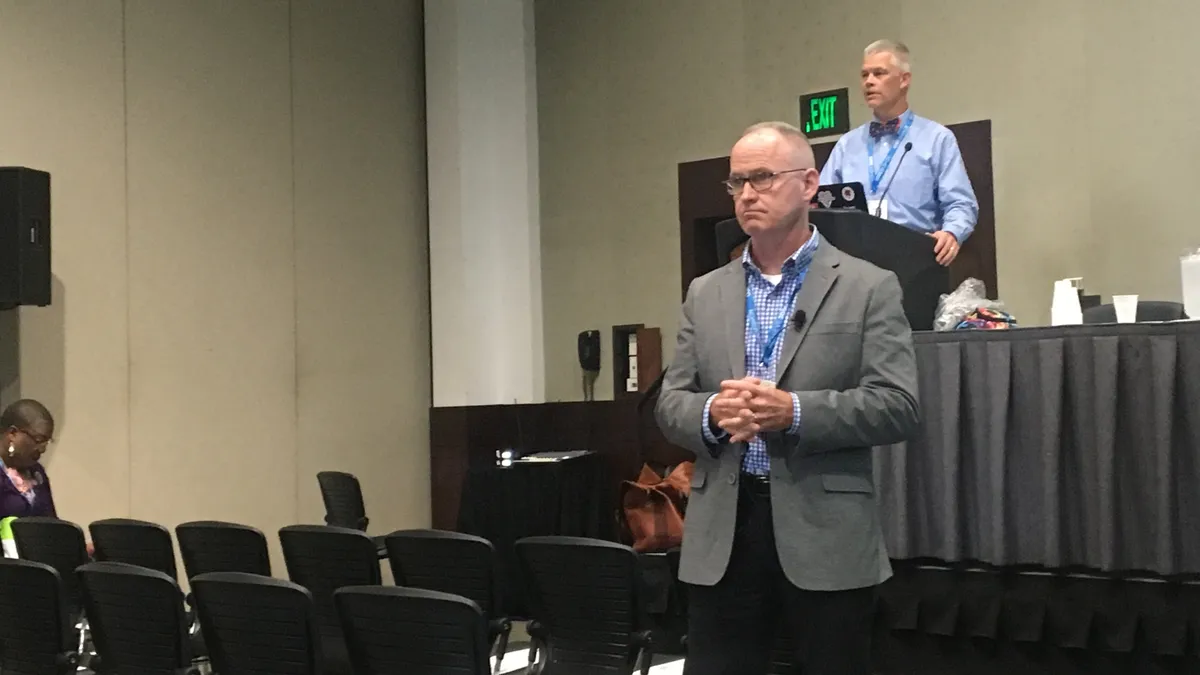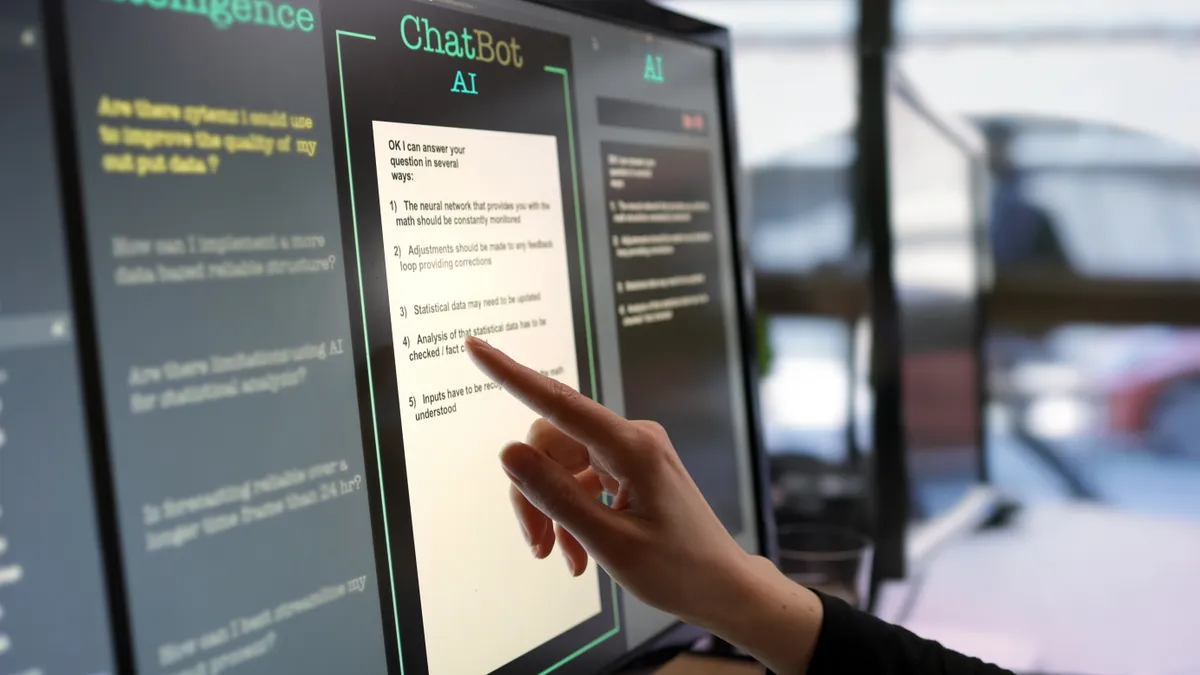Though often spotlighted for their perceived counter-productive roles in social discourse, social media platforms — particularly Twitter — have grown to play a prominent role in education, allowing educators from across the globe to share their best practices.
It's a concept that thought leaders and former administrators like Jimmy Casas, Jeff Zoul and Todd Whitaker have come to be known for in their conference appearances, and hashtags like #BFC530 have popped up over the years for a practice some administrators have labeled "PD in your PJs."
And in a crowded Thursday afternoon session at the 2019 National Principals Conference in Boston, three middle school principals had a chance to demonstrate what they've learned from their peers on social media.
Notably, their first face-to-face collaboration came during lunch just hours before their presentation.
"I don’t know if any of you came to see conjoined triplets, because the session is called 'Connected in the Middle,'" Don Gately, principal of New York's Jericho Middle School, joked, saying he didn’t want anyone to be disappointed.
Joe Mazza, principal of Seven Bridges Middle School in Old Westbury, New York, then stated that the session is really about what principals have learned in their nine or 10 years of being on Twitter and how can they leverage it.
"It’s so great to see so many middle school people here, because you get it," Gately added.
School leaders' family members often can't relate to what administrators deal with every day, said Jay Posick, principal of Merton Intermediate School in Merton, Wisconsin. This makes finding and connecting with peers who have shared experiences all the more important. The connections you make via social media can be very powerful and change how you approach your role as an educator, he said.
So what exactly have they learned? Here are seven of the best ideas they shared.
Getting students to read
The amount of reading students do on their own time often drops off once they reach the middle school grades. Gately said one idea he got from Twitter was having teachers include the books they’re currently reading on their doors with the rest of their basic personal intro information.
He also got the idea to have the library put QR codes on books linking to reviews. Both approaches are geared toward not only getting students to read more, but also getting adults to model that behavior.
Rethinking professional development
Middle school teachers need professional development (PD) experiences that are specific to their needs, Gately said. One thing his school did at faculty meetings this year was called "Name it, claim it, explain it," where a photo of students was put up and teachers had to explain what the students were doing in the picture.
He also recommends the "Pineapple Chart," where teachers can place a post-it note on a "pineapple" schedule chart to welcome other teachers into their classrooms during times that they’re doing something they want to share. Also helpful is "20% PD time," which allows educators to dedicate a fifth of professional learning time to a passion area, in addition to taking advantage of participant-driven Edcamp PD "unconferences."
Some people have even invited students to lead sessions during faculty Edcamps, Gately said.
Giving teachers (and leaders) feedback
When the #ObserveMe hashtag was going around, Gately got the idea to put a sign on his door with a QR code where users could provide feedback to questions like “Am I ‘present’ in my interactions and connections? (not distracted by device or ‘other’ things)” and “Am I using my time well? Am I focused on what matters (kids, learning, relationships)?” Many of his teachers followed suit and did the same thing.
Posick also recommended using Voxer, a walkie talkie messaging app, to offer feedback to individual teachers after informal class visits.
Fostering positive interactions
Middle school students are relational, and Posick said holding “Circle of Respect and Power” sessions with students each month helps to build positive relationships and interactions by having each person in the circle share something they like about the next one. It also requires educators and administrators to get to know students so they have something to say no matter which student they’re sitting next to.
Posick also said he uses a "jammy pack" — a fanny pack with built-in Bluetooth speakers — at lunch, pick-up/drop-off and recess, playing music so students gather and sing and dance. He said he uses Nicktoons music to "avoid naughty words," and while he doesn’t know half the songs, his students still show up to sing when their favorite plays.
Giving students voice
Attention has grown lately to giving students more say in their daily school experiences. One area where Gately listened to what they had to say was on the topic of locks for lockers. He experimented with sending locks to students finishing 5th grade the summer before they start 6th grade so they would know how to use them when school started. Not a single lock was lost, and all students showed up knowing how to open their lockers.
Mazza said he didn’t know any of the students when he started at his new school in December. Using Canvas, the school's learning management system, he launched a different poll every other week to learn what students thought about lunch or recess, what they’d do to transform the cafeteria, 1:1 technology, clubs and other extracurricular programs. Such polls can help inform decisions around various initiatives.
He added that Twitter chats are also a great place to learn about student voice.
Posick said his school allowed any students who wanted to be part of a student senate to join, throwing out the election process. Out of roughly 400 students, over 100 students expressed interest. The student senate also invites him to meetings with lists of things they want to do, further increasing their voice in school life.
Improving transitions
The middle school years are transitional by nature, and students sometimes struggle as they move through those grades. Gately’s staff used Flipgrid to share a directory with welcome videos and other material, allowing students and parents to become more comfortable with transitions to new grades and classes. This can be particularly beneficial for the transition from middle school to 9th grade, he said.
Posick agreed, saying those efforts can “go an awfully long way.”
Involving parents
Middle school parents can be as uncertain as their children, and they're also often busy. Gately recommends using Periscope to livestream what’s going on in classrooms or in the cafeteria. This can also help them virtually attend school events involving their children if they have to work.
Mazza floated the idea of introducing ParentCamp meetings to partner parents and teachers, finding out what parents want and providing that information to them. Twitter is also a convenient avenue for sharing documents and other information, meeting parents where they are at, he said.
Finally, the principals recommended using a "good news call of the day" to share positive information, making both students and parents feel great.







 Dive Awards
Dive Awards
















